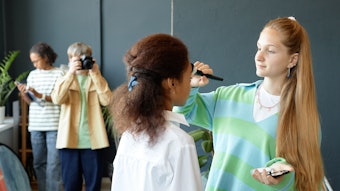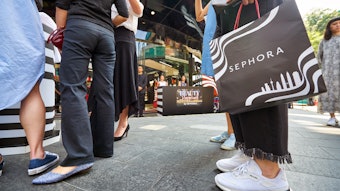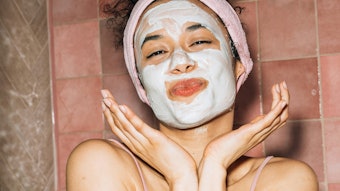
- Multinationals have increasingly focused efforts on men’s lines in a bid to counteract ailing sales in other categories.
- A pattern has emerged in men’s grooming, whereby the category mimics trends in the wider market as a whole, particularly in skin care.
- Slow growth in developed markets was partially offset by vibrant sales in emerging regions.
- The real untapped territory for men’s grooming is in the Middle East and Africa.
- Sachet packet marketing, long been used successfully in emerging regions, is now being used to grow market share among price conscious men in developing markets.
In 2008, men’s grooming was worth $26 billion globally, accounting for 8% of the total global cosmetics and toiletries market, and this total is set to rise. While the more mature markets, such as the U.K., are beginning to show signs of reaching maturity, the rise of the metrosexual male in emerging markets is fueling sales. Recognizing this shift, multinationals have been focusing their efforts increasingly on men’s lines in a bid to counteract ailing sales in other categories of their personal care product portfolio—and are starting to look for opportunities in new markets.
Feminization of Men’s Products
The difference in male and female personal care is becoming increasingly blurred. A definite pattern has emerged in men’s grooming, whereby the category mimics trends in the wider market as a whole, particularly in skin care. A possible benefit of this is that the products that are currently being mimicked can be used to give an indication of which direction the male grooming market is likely to take next.
Fair and Handsome, the male skin-whitening brand launched in 2005 in India, has seen its share growing in the country year on year. This product mimics the long standing trend for female skin-whitening products in the country. While the brand reached an impressive $13 million in sales in 2008, its sales are still only worth 4% of Fair and Lovely’s, the number one selling female skin-whitening product in India. Its endorsement by Shahrukh Khan, the ubiquitous Bollywood actor, has helped to overcome male reluctance about using a product with strong female connotations. It is likely that within five to 10 years, sales of male skin-whitening products could reach similar levels of value sales as female skin whiteners.
In Western markets, the trend for tanning products, long present in the general market, has taken off in the male specific market—with products such as L’Oréal Men Expert, a gradual tanning moisturizer, proving successful, especially in the U.K. market. As with Fair and Handsome, the product mimics a best-selling product in the general female market (Johnson & Johnson’s Holiday Skin) and the countless copycat gradual tanning moisturizers it spawned.
The functionality and ingredients of male-specific products, in reality, are almost identical to the general versions; the difference is in the packaging and the way the products are marketed. The color of men’s grooming products is crucial for success in the market—most of the leading brands such as Nivea for Men and Gillette stick to traditionally male colors such as blue, white and silver.
U.S. Remains Largest Single Market
With sales of $4.7 billion, the U.S. is by far the largest single market for men’s care, and has nearly doubled in value size during the past 10 years, rising from around $2.7 billion in 1999, according to Euromonitor International. Many male grooming brands that have been present in Western Europe for many years, such as Axe, have recently moved into the U.S. market, and this has helped grow acceptance of European concepts of male grooming among American men.
The Japanese male grooming market is the largest in Asia—five times bigger than China’s, despite the latter’s much larger population while its disposable income remains only a third lower. The difference is largely due to the strong acceptance of male grooming habits in Japan, and male-only beauty stores/salons are commonplace in the country.
Western Europe Dominates Regional Sales
The men’s market in Western Europe was worth an impressive $8.5 billion in 2008, accounting for a total of 31% of the global men’s market segment and far surpassing even nearest rival North America. The French, German and U.K. markets alone comprise more than 50% of all value sales in men’s lines in Western Europe, but all three are now showing signs of stagnation and maturity, as emerging regions continue to grow. Slow growth in developed markets was partially offset by vibrant sales in emerging regions—particularly Eastern Europe and Latin America. Both regions saw double-digit growth across all categories of the industry because their economies were yet to feel the impact of the recession—and also because the men’s grooming markets there are yet to reach the levels of maturity seen in the West. Indeed, the size of the men’s hair care market in Latin America has already overtaken that of Western Europe, largely thanks to a wealth of new product launches in male shampoos, mainly from major players in the region such as Grupo Bertin.
The real untapped territory for men’s grooming is in the Middle East and Africa. Despite having a combined population of more than one billion, the regions account for a mere 4% of the global men’s market with a value size of $747 million. These regions are among the hardest for manufacturers of men’s lines to penetrate, as consumers’ attitudes to male grooming are highly traditional and, therefore, currently confines sales to basic products.
BRIC Nations Crucial for Growth
Brazil, Russia, India and China (BRIC) are highly important for the industry, as they alone currently account for 16% of the total global value sales in male grooming, up from 13% in 2003. All four nations have experienced rapidly growing wealth and growing acceptance of male beauty habits, but Brazil leads due to strong demand for value added men’s shaving products and men’s toiletries such as hair care products, which are more expensive than the basic products that dominate sales in the other BRIC countries.
Men’s grooming products saw 14% current value growth in 2008 in China. The major consumer purchasing group for men’s grooming products continued to shift from girlfriends or wives to men themselves. The recent launch of FHM in China (which features the latest new personal care products for men) helped to spread the acceptability of male grooming and contributed to the strong current value growth in male toiletries.
Major Players Focus on Emerging Regions
The global heavyweights in the industry have recognized the development potential offered by consumers outside the traditional focal regions, and several have begun to develop their business in these countries, with a view to long-term growth. Procter & Gamble has recently turned its attention to the Mexican market, and began building a $250 million plant for the production of Gillette razors and blades in Guanajuato, Mexico, in May 2009. The move will create 2,400 new jobs, and the plant will supply North and South America—as well as parts of Europe and Asia.
Beiersdorf is focusing its marketing efforts on pushing the Nivea for Men brand in men’s skin care in China. In May 2009, it opened a new production plant to manufacture body care products in Shanghai, China. The plant cost approximately €18 million, and the capacity is eventually expected to reach up to 25,000 tons per year to continue to meet the growing demand for personal care products in the region.
In May 2009, L’Oréal shifted its focus to the BRIC nations by launching Garnier Men in India—the first market in what will become a global launch. The range features skin-whitening cream for men, and the brand is promoted by the Bollywood star John Abraham. It will compete for sales in the lucrative male skin-whitening market against the aforementioned current leading brand—Fair and Handsome, owned by Emami.
Sachet packet marketing, long been used successfully in emerging regions as a way to grow sales among lower-income consumers who could not otherwise afford full-sized products, is now being used by the major players to grow their market share among price-conscious men in developing markets. The share of the Clinicare (Procter & Gamble) shampoo brand in India was greatly boosted in 2008 thanks to sachet marketing. The format is ideal for male grooming products because ubiquity increases product familiarity and helps to break down cultural stigma surrounding the use of male toiletries in emerging regions. Men’s lines in sachet format were also introduced at the beginning of 2009 by Beiersdorf Thailand Co Ltd, and sachets are expected to prove as successful as they have been in other areas of personal care.
Even with signs of improvement in the recession-hit Western markets, growth in the long term will slow down as they naturally begin to reach maturity. To sustain growth, it is vital for manufacturers to continue to look to developing markets and to use innovative, tailored strategies that could attract lifelong customers from new male consumers.
Carrie Lennard is a research analyst at Euromonitor International.










